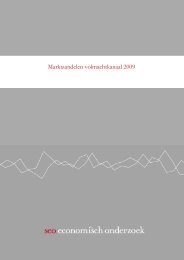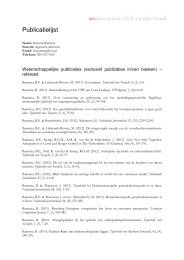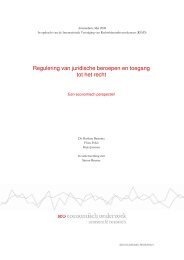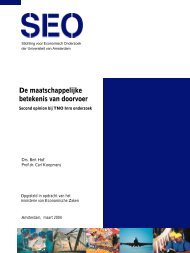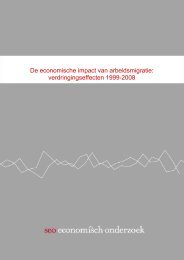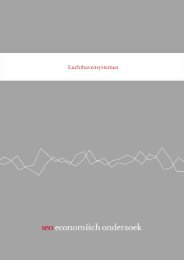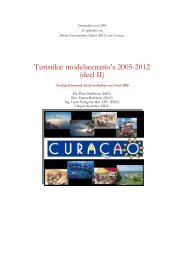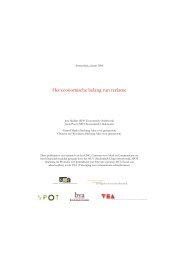Amsterdam, Netherlands - SEO Economisch Onderzoek
Amsterdam, Netherlands - SEO Economisch Onderzoek
Amsterdam, Netherlands - SEO Economisch Onderzoek
Create successful ePaper yourself
Turn your PDF publications into a flip-book with our unique Google optimized e-Paper software.
coalition partners in the business community. This occurs when the demand from the region doesnot allow the HEI to generate products with the required scientific standard. In this case theincentives on both sides of the market do not dovetail leading to a mismatch between the supplyof and demand for knowledge.However, even when incentives are perfectly aligned the equilibrium of supply and demand forknowledge would reside at a suboptimal level when viewed from a social perspective. The reasonfor this social disequilibrium is the existence of external effects which may have a positive valuefor society such as general health and employment effects but do not represent private gainswhich are included in the cost-benefit calculus of investors. In other words, there are socialbenefits which are ‘lost’ in the market place; the market fails from a social perspective. In publicgoods theory this forms a cause for the government to interfere and to boost the volume ofinvestment in knowledge through stimulating measures like a subsidy to lower the costs of R&Dinvestment.We have seen in this report that in the <strong>Netherlands</strong> such measures are the province ofthe national government. The HEIs in the <strong>Amsterdam</strong> region hardly receive financial means forinnovation from regional governments. Generally innovation programs like <strong>Amsterdam</strong> Topstadare on their turn at least partly financed by national funds for regional economic development,like Pieken in de Delta. Although there are a few cases in <strong>Amsterdam</strong> which do involve a directfinancial commitment from the city community, such as <strong>Amsterdam</strong> University College, theScience Park <strong>Amsterdam</strong> and the Life Science Fonds <strong>Amsterdam</strong>.The role of the city community in <strong>Amsterdam</strong> is first and foremost that of a catalyst. It tries tobuild bridges between the different partners in the region – between the HEIs among themselvesand between the HEIs and the business community – as a means to improve the climate forinnovation. The community also tries to attract new knowledge institutes to the region and tocreate an attractive investment climate for investing firms, especially those working in keyeconomic clusters such as the life sciences and the creative industry. The city community alsorecognizes the importance of the interaction between an attractive living environment and theinvestment climate. City promotion must raise the region’s image as a knowledge hub andstimulate the influx of R&D-investment and knowledge workers.Contribution to the labor market and social well-beingCoalition building in the labor market takes place on a different footing. The UASs in the regionactively seek cooperation with the business community in order to monitor the demand for theskills of their graduates. This awareness of the link between education and the needs of the labormarket is much less developed among the two universities. One of them explicitly states that“solving labor market shortages is not one of our tasks”. The universities offer their studentsskills and competences which first and foremost meet academic standards, although they mustallow graduates to compete on the labor market. When we examine the labor market statisticsthey succeed admirably in this task. The unemployment rate of workers with higher education inthe <strong>Amsterdam</strong> region is very low and far lower than the unemployment rate of workers withlower types of education. The labor market is not a problem that should concern the HEIs.Or is it? There are at least three reasons to argue that the HEIs should be engaged in labor marketcoalitions. First, in the past decades the participation in higher education has been expandingrapidly. This has resulted in a rapid growth of the share of higher educated in the labor populationwhich in the <strong>Amsterdam</strong> area is almost 40%. This seems high, but it is not high enough. Skillbiasedeconomic growth causes an even more rapid increase in the demand for higher educatedworkers resulting in a rising skill premium (Jacobs, 2004; Nahuis and de Groot, 2003). In order tofacilitate this rising demand the HEIs need to attract more students, which means finding them ingroups which are now underrepresented in higher education such as the non-Western foreignDutch nationals. The growing participation rate of these students in higher education, especiallyat UASs such as INHolland, indicates that they are indeed trying to achieve this task. The secondreason for HEIs to actively monitor the labor market is the emerging need for life-long learning.Workers with qualifications at secondary levels increasingly experience the need to get a degree130



